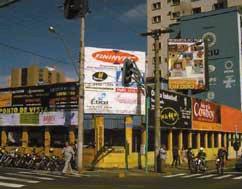Brazil
: São Paulo Bans Outdoor Advertising
 Depending upon who‘s talking, São Paulo‘s new law to ban or heavily restrict most outdoor ads is either a major step to a more attractive city or one that will destroy a thriving business sector and leave the city colorless and grey. The new law takes effect January 1, 2007 and bans the majority of outdoor ads, including billboards, giant video screens and electronic panels. Even the giant Itaú electronic sign atop the Conjunto Nacional on Avenida Paulista is not exempt, though the huge companion digital clock would live on. All offending signs must come down by the end of the year.
Depending upon who‘s talking, São Paulo‘s new law to ban or heavily restrict most outdoor ads is either a major step to a more attractive city or one that will destroy a thriving business sector and leave the city colorless and grey. The new law takes effect January 1, 2007 and bans the majority of outdoor ads, including billboards, giant video screens and electronic panels. Even the giant Itaú electronic sign atop the Conjunto Nacional on Avenida Paulista is not exempt, though the huge companion digital clock would live on. All offending signs must come down by the end of the year.
The law is part of Mayor Gilberto Kassab‘s "Clean City" campaign. While the city stands to lose approximately R$3 million annually in tax receipts as a result of the ban, Mayor Kassab told the Folha de São Paulo that the "income is small and we‘ll let it go in order to have a prettier city." The outdoor advertising and associated industries see it differently. Raul Nogueira Filho, president of the trade association Central de Outdoor told the Folha that businesses connected with outdoor media are evaluation their options. "We are being pushed toward the courts," he said.
Besides banning billboards and electronic signs, more restrictive rules regarding everyday business signage are part of the new law. For example, the average McDonald‘s "totem" sign in São Paulo is 10 meters high. The new maximum is five meters. Signs on façades will be tied to a mathematic formula depending upon the amount of street frontage occupied by each business. The ban also includes distributing pamphlets at traffic signals. Controlled ads will be allowed on newsstands, public trash cans and urban clocks.
Júlio Albieri Neto, president of Sepex, which represents outdoor publicity companies in São Paulo, was quoted in Folha as saying around 20,000 people stand to lose their jobs and about 200 businesses will close. "The sector will go into liquidation," he said.
The new law does not address several other sources of visual pollution in São Paulo, such as graffiti, lack of green space and broken sidewalks. However the proposed 2007 municipal budget does contain a line item to begin burying the wires and cables that are strung across the city by the tens of thousands.
Previous city administrations have also tried to take on Sao Paulo‘s visual pollution. Jorge Wilheim, the Secretary of Urban Planning under former mayor Marta Suplicy, told the Estado de São Paulo "we proposed many restrictions, but not all, because there are certain situations that should be discussed individually." he said. "There are cases where Gisele Bündchen‘s legs in an ad are more beneficial to the urban landscape than an unpainted, degraded wall on the side of a building."
(Published by Gringoes, October 10, 2006)